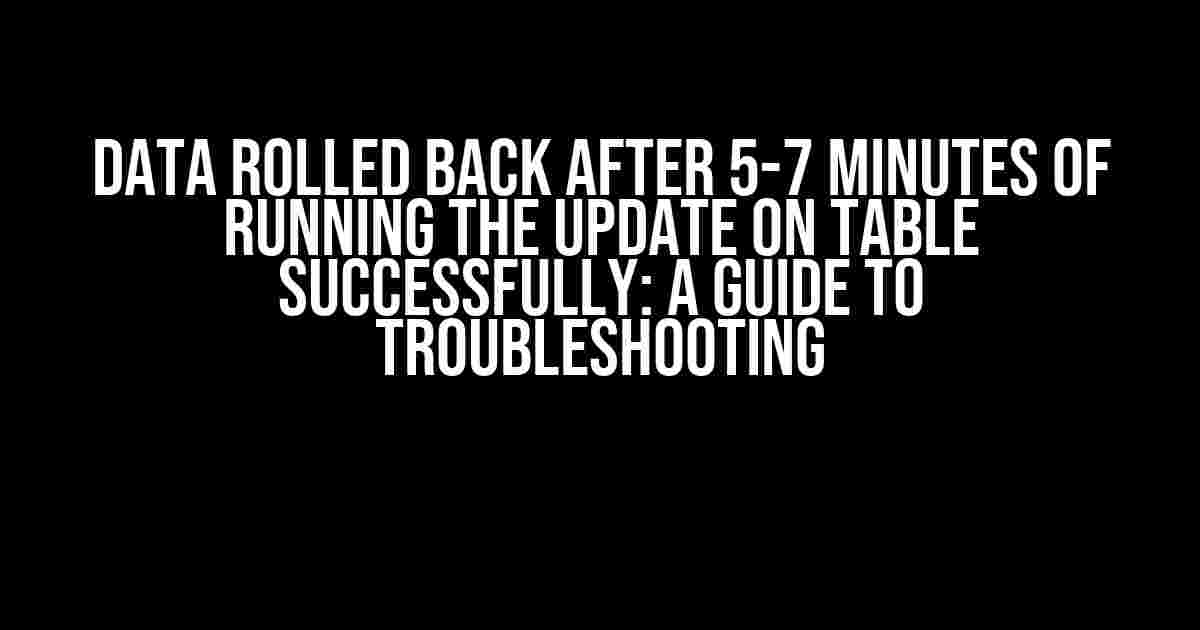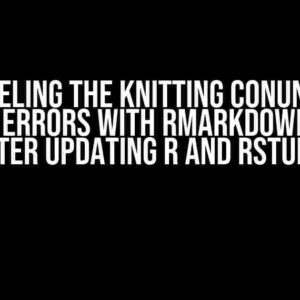If you’ve ever encountered the frustrating issue of data rolling back after a successful update on a table, you’re not alone. It’s a common problem that can occur due to various reasons, leaving you wondering what went wrong. In this article, we’ll delve into the possible causes of this issue and provide step-by-step instructions on how to troubleshoot and resolve it.
Understanding the Problem
When you update a table in your database, you expect the changes to be persisted. However, in some cases, the data may roll back after 5-7 minutes, leaving your table in its original state. This can be a perplexing issue, especially if you’ve received a success message indicating that the update was successful.
Causes of Data Rollback
Several factors can contribute to data rolling back after an update. Some of the common causes include:
- Transaction timeout: If the transaction takes too long to complete, the database may roll back the changes to ensure data consistency.
- Locking issues: Concurrent updates or locks on the table can cause the update to fail, resulting in a rollback.
- Trigger failures: Triggers can cause the update to fail, leading to a rollback.
- Corrupted indexes can prevent the update from being persisted, causing a rollback.
- Resource constraints: Insufficient resources, such as memory or disk space, can lead to a rollback.
Troubleshooting Steps
To identify and resolve the issue, follow these step-by-step instructions:
- Check the database logs: Review the database logs to identify any error messages or warnings related to the update. This can help you pinpoint the cause of the rollback.
- Verify transaction isolation levels: Ensure that the transaction isolation level is set correctly. A lower isolation level can lead to concurrency issues, causing rollbacks.
- Analyze table locks: Use tools like
sp_lockorsys.dm_tran_locksto analyze table locks and identify any blocking issues. - Inspect trigger definitions: Review trigger definitions to ensure they are not causing the update to fail.
- Run database consistency checks: Run
DBCC CHECKDBandDBCC CHECKINDEXto identify any index corruption or consistency issues. - Monitor system resource utilization: Check system resource utilization, such as CPU, memory, and disk space, to ensure that resources are not exhausted.
- Test the update in isolation: Isolate the update and test it in a separate transaction to identify if the issue is specific to the update or a broader problem.
Resolving Data Rollback Issues
Once you’ve identified the cause of the data rollback, take the following steps to resolve the issue:
| Cause | Resolution |
|---|---|
| Transaction timeout | Increase the transaction timeout, or optimize the update to reduce execution time. |
| Locking issues | Optimize queries to reduce locking, or implement row-level locking instead of table-level locking. |
| Trigger failures | Debug and fix trigger errors, or disable triggers temporarily to isolate the issue. |
| Index corruption | Rebuild or reorganize indexes, or run DBCC CHECKINDEX to identify and correct index corruption. |
| Resource constraints | Optimize resource utilization, add more resources, or schedule the update during off-peak hours. |
Conclusion
Data rolling back after a successful update can be a frustrating issue, but by following the troubleshooting steps outlined in this article, you can identify and resolve the problem. Remember to check database logs, verify transaction isolation levels, analyze table locks, inspect trigger definitions, run database consistency checks, monitor system resource utilization, and test the update in isolation. By taking these steps, you can ensure that your updates are persisted and your data remains consistent.
Remember, a thorough understanding of your database and its dependencies is crucial in resolving data rollback issues.
Additional Tips and Best Practices
To minimize the likelihood of data rollback issues, follow these best practices:
- Regularly maintain your database: Schedule regular maintenance tasks, such as indexing, statistics updates, and consistency checks.
- Optimize queries: Optimize queries to reduce execution time and minimize locking issues.
- Use transactions wisely: Use transactions judiciously, and ensure that they are committed or rolled back explicitly.
- Monitor database performance: Continuously monitor database performance, and address any issues promptly.
- Implement error handling: Implement robust error handling mechanisms to catch and handle errors gracefully.
By following these best practices and troubleshooting steps, you can ensure that your database remains healthy, and data rollback issues become a thing of the past.
Here are 5 FAQs about “Data rolled back after 5-7 minutes of running the update on table successfully”:
Frequently Asked Question
Get answers to your most pressing questions about data rollback after updating a table!
What happens when my data rolls back after an update?
Don’t panic! When your data rolls back, it means the update was successful, but the changes were undone. This usually happens due to various reasons such as system errors, timeouts, or conflicts with other processes. Your data is safe, and you can try the update again.
Why does the rollback happen after 5-7 minutes of running the update?
The 5-7 minute window is likely a timeout period set by your system or database. During this time, the update is processed, and if it’s not completed successfully, the system automatically rolls back the changes to ensure data integrity.
Is my data still updated if it rolls back?
No, when the data rolls back, the update is cancelled, and your data reverts to its original state before the update. This means any changes made during the update process are lost, and you’ll need to try the update again.
How can I prevent data rollback in the future?
To minimize the risk of data rollback, ensure your system and database are stable, and the update process is optimized. You can also consider implementing error handling mechanisms, such as retries or idempotent updates, to reduce the likelihood of rollbacks.
Who should I contact if I encounter frequent data rollbacks?
Reach out to your system administrator, database administrator, or a technical support team for assistance. They can help investigate the root cause of the issue, provide guidance on optimizing your update process, and ensure your data is safe and up-to-date.


